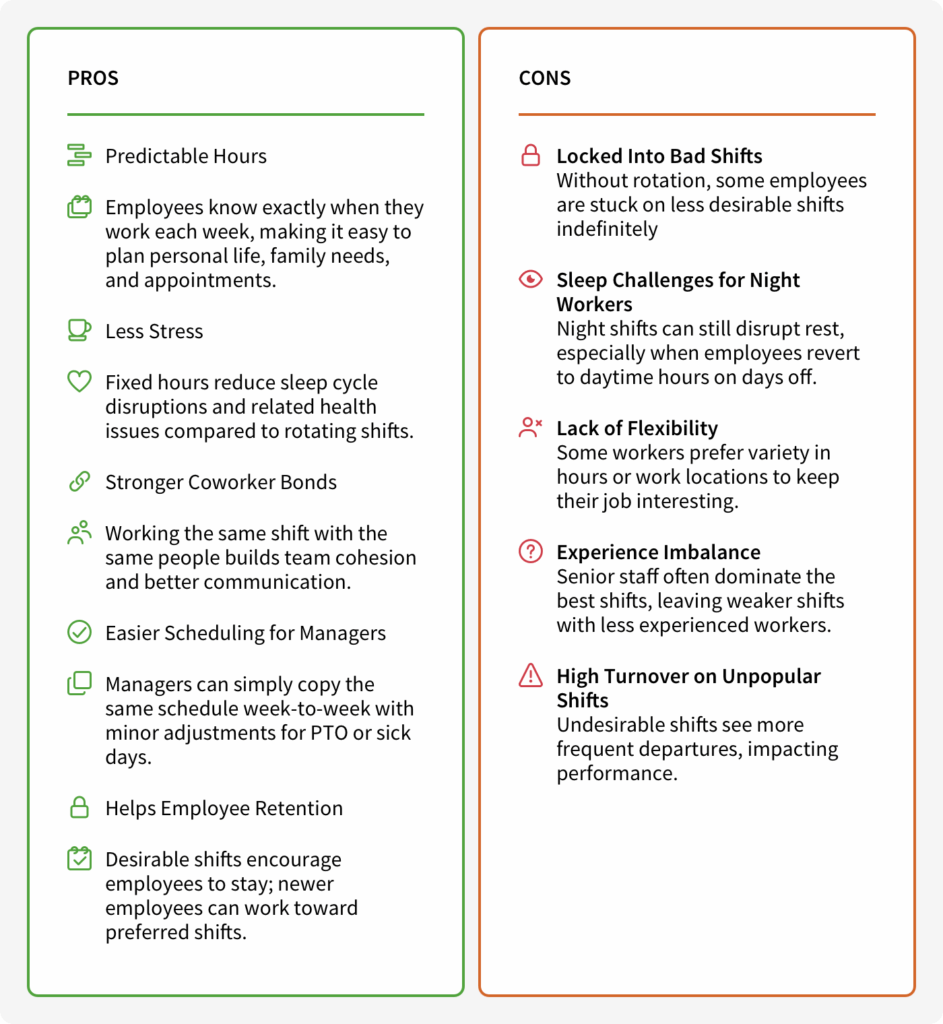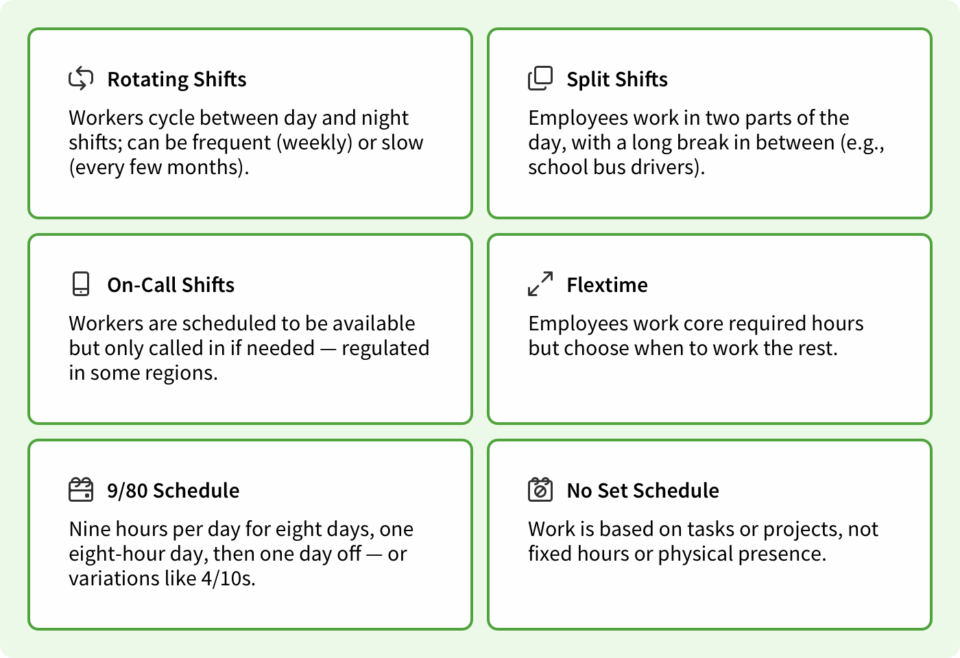Manager’s Guide To Fixed Work Schedules
Try When I Work for free
Even in the day and age of increased flexibility, a fixed work schedule is a benefit to your employees. Fixed schedules give your workers a schedule that doesn’t change, which allows them adequate time to rest and recharge, plan their lives, and make time for family and friends.
Every morning Rebecca gets up at the same time and is at work by 8 a.m. She has her lunch break at noon, and heads home by 5 p.m. She has weekends off. She plans her appointments and errands on the weekends, after work, or over her lunch break.
Her roommate’s schedule looks very different. Sometimes he’s coming home as she’s leaving, and sometimes they leave around the same time. He carefully checks his schedule on an app every time his boss releases it so he can make plans.
One has a fixed work schedule, the other does not.
When we think of people working 9-to-5, we’re thinking of fixed work schedules. Rebecca would be a classic example, though not all fixed schedules are structured exactly like that.
A fixed schedule is any schedule that doesn’t change. While there is an increasing rise in alternate work schedules, the fixed work schedule remains stubbornly popular.
But not every business can use a fixed work schedule.
What if you’re open 24 hours? What if you’re open 12 hours? What if you’re open on the weekends? Have seasonal fluctuations in customer demand?
We’ll show you the pros and cons of a fixed work schedule so you can decide if it’s right for you and your employees.
What is a fixed work schedule?
A fixed work schedule is one that doesn’t change. That means your employees can expect to work the same amount of hours, at the same time, on the same days, every single week. They always know what time they have to clock in and out and there’s never any question of when they work next.
There are a few different variations of fixed schedules, including:
- 9-5 work schedule. A fixed schedule where employees work for eight hours, five days a week. Typically this would be scheduled from 9am to 5pm, but some employers change it to start at 8am so employees have a one-hour unpaid lunch break.
- 4/10 work schedule. A fixed schedule with four days of ten hours each (also known as a compressed workweek).
- 9/80 work schedule. A fixed schedule covering a two-week period, eight days have nine hours, one day has eight hours, and one day is off. An alternate version would be 4/10, with four days of ten hours each (also known as a compressed workweek).
Pros and cons of fixed work schedules

Generally, fixed work schedules have full-time employees working 35-40 hours a week with a standard eight-hour day for a five-day work week.
There are variations (which we’ll get to), but with this generalization in mind, let’s take a look at it from the employee and manager points of view.
Advantages:
Employees like fixed work schedules because:
- It’s predictable. They know the hours they’ll work, and can plan around it. When you know your schedule is the same week after week, it’s very easy to balance your work and your personal life. It’s easier to plan for family needs, school, appointments, daycare, and events, and that stability and predictability trickles down into their household. Family members know when they’ll be home.
- It’s less stressful. Fixed work schedules also prevent the health issues that come from rotating shifts that can mess with your sleep cycle. When your work shift is the same, your sleep patterns don’t have to change.
- It fosters a better connection with coworkers. When you work the same shift with the same people, you have an opportunity to connect. Communication and relational creativity is greater than if you were working with a different group of people every time you came to work. Fixed schedules create unit cohesion.
Managers like fixed work schedules because:
- It’s easier to build the schedule. Building schedules is simple because they simply repeat. If you’re using a scheduling app like When I Work, you simply copy the schedule from one week to the next. The only changes are sick days and paid time off requests.
- Workforce planning is easier. With repeat and predictive scheduling, workforce planning is a snap. The thing about fixed work schedules is you can easily see where you’re headed because you’re dealing with the same days and hours.
- It offers a free incentive to stick around. Fixed work schedules can help with employee retention. If you have a shift you like, you don’t want to leave. If you’re new and have a less-than-desirable shift, stick around long enough and you’ll get the preferred shift, too.
Disadvantages:
Employees don’t like fixed work schedules because:
- They can get stuck on a bad shift. Rotating shifts allow the “good” and the “bad” shifts to be shared among all employees. Fixed work schedules don’t.
- Sleep can still be hard to come by. For some people, working the night shift is something they never adapt to. And on the weekends or days off, many revert to a “normal” day so they can be with their family. That means a constant state of disrupted sleep patterns.
- They actually want flexibility. Previous generations may have appreciated the predictability of a fixed work schedule, but not all of today’s workers want that. Some grow bored with the sameness, and prefer flexibility and frequent updates. Different location, different time, different shift—it keeps things feeling new. They don’t want to be stuck at work so much every day.
Managers don’t like the fixed work schedules because:
- Experience is weighted towards the better shift. The more experienced workers usually have the most seniority, and that means they’re probably all on the better shift. It’s hard to spread the experience and work quality around to all the shifts. Putting workers with seniority on less popular shifts means you run the risk of them leaving.
- Turnover on unpopular shifts is high. If people don’t like a particular shift, that shift may suffer from continual turnover. Combine that with inexperienced workers in general, and that shift becomes a weak spot.
- Scheduling is much more challenging. When you’re dealing with work schedules where different people are always on different shifts, it’s a lot to keep track of. It takes more time to schedule employees.
Fixed vs. rotating schedules
The differences between rotating work schedules and fixed work schedules are significant. Nearly 45% of workers with irregular or rotating work schedules struggle with work-family conflict, while just over 10% with a fixed work schedule make the same claim. That has an impact on the employee’s focus, attitude, and willingness to stay on the job.
However, your business may not be able to function with a fixed work schedule. If that’s the case, are you stuck with unhappy employees? High turnover?
Absolutely not. There are other kinds of work schedules that you can use, and you can mix more than one type together, to find the best solution for everyone.
Alternative types of work schedules
There’s no shortage of ways to arrange your work schedule. Some of these types would fall under the category of rotating work schedules, while others are unique on their own.

- Frequent rotating shifts. Employees cycle from day and night shifts from week to week. This can be very hard on people and lead to significant burnout.
- Slow rotating shifts. Employees cycle from day and night shifts over the course of several weeks or months to cut down on sleep pattern issues.
- Weekend rotating shifts. Employees take turns working weekends.
- Partial rotating shifts. Some employees work fixed schedules, while others have rotating schedules. This may be because of differences between hourly and salaried workers, or qualification requirements that require some employees to always be on certain shifts.
- Split shifts. Employees split their shift in the day, generally because they are needed at different times. (e.g. a school bus driver is needed before and after school, but not during).
- On-call shifts. Employees are scheduled, but only come in if needed. Be wary of this one; new rules and laws—called “fair workweek” laws—have popped up in cities and states to put a stop to this, as it is hard on employees.
- Flextime schedule. A set number of hours (“core” hours) must be worked during a standard time, with the remaining hours worked however the employee prefers.
- No schedule. When the work that needs to be done is about completing projects or responsibilities, not the hours worked or when an employee is present, there is no need for any schedule.
There are so many ways you can set up your schedule based on what you need, your customers need, and your employees need. It is possible you can get the right employee coverage you need by using a mixture of these schedules.
It isn’t possible to do that, though, unless you have a robust employee scheduling app.
How to manage any schedule
When I Work can help with any type of scheduling, whether that’s a basic fixed schedule that you quickly copy from week to week, or a more complicated rotating or mixed version. From schedule templates, flexible self-scheduling, employees swapping shifts with each other, and easy internal communication, we can make even the most complicated shift easy to manage.
Signing up is easy—get started exploring a better schedule with our 14-day free trial.






